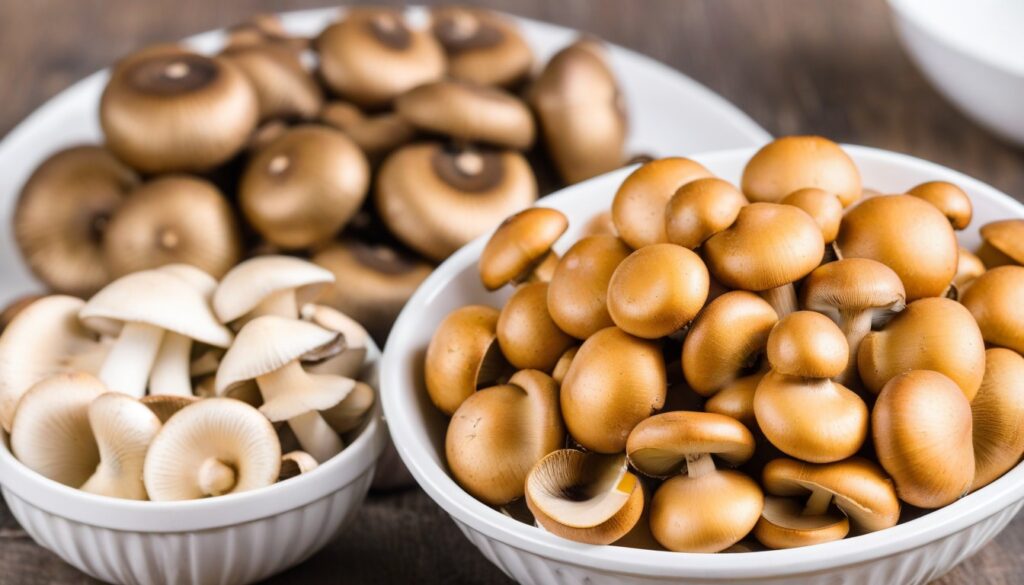Mushrooms are a beloved culinary ingredient, but is it better to use canned or fresh mushrooms in your meals? The answer isn’t straightforward, and it largely depends on your personal preferences and priorities. In this article, we will explore the various factors that affect the flavor, nutrition, storage, cost, and environmental impact of canned and fresh mushrooms. By the end of this article, you will have a comprehensive understanding of these two options, helping you make an informed decision that is better suited for your needs.
Key Takeaways
- Canned and fresh mushrooms have distinct flavor profiles, texture, and aromas
- Fresh mushrooms typically have higher nutritional value compared to canned mushrooms
- Both canned and fresh mushrooms have varying shelf life and require proper storage methods
- Mushrooms are versatile and can be used in a wide range of culinary applications
- Cost and environmental impact are also factors to consider when choosing between canned and fresh mushrooms
Flavor Profile of Canned Mushrooms
Canned mushrooms have a unique flavor profile that sets them apart from fresh mushrooms. While they still include the rich, umami taste that makes mushrooms such a popular ingredient, the canning process can alter their texture and flavor.
One of the benefits of canned mushrooms is that they can be used to add a mushroom flavor to a dish without having to slice and cook fresh mushrooms, which can be time-consuming. Canned mushrooms tend to have a softer, more tender texture than fresh mushrooms, and some people enjoy the smoother mouthfeel that can result from this.
It’s worth noting, however, that canned mushrooms often have a more intense, concentrated flavor than fresh mushrooms, which can be a good or bad thing depending on the recipe. Some people enjoy the robust, bold taste of canned mushrooms and find that they work well as a topping for pizza or as a base for mushroom soup. Others may find the potent flavor overwhelming and prefer the subtler taste of fresh mushrooms.
Ultimately, the flavor of canned mushrooms comes down to personal preference and the specific dish where they’re being used. While they don’t offer the same earthy, natural flavor of fresh mushrooms, they can still be a delicious addition to many meals.
If you’re particularly sensitive to flavor and texture differences, it’s worth experimenting with canned and fresh mushrooms in different dishes to see which you prefer.
Flavor Profile of Fresh Mushrooms
When it comes to flavor, fresh mushrooms offer a distinctive taste that many home chefs prefer. The natural earthy taste and aroma of fresh mushrooms create a bold and rich flavor that can enhance dishes in various cuisines.
One of the primary reasons people choose to use fresh mushrooms is their texture. Fresh mushrooms have a firmer texture than canned mushrooms, allowing them to retain their shape and provide a more satisfying mouthfeel. The texture of fresh mushrooms can be a crucial factor in dishes such as salads, where their raw texture can add a refreshing crispness.
Another characteristic that sets fresh mushrooms apart from canned mushrooms is their versatility in cooking. Fresh mushrooms’ flavor pairs well with a wide range of ingredients and spices, making them a go-to ingredient in many dishes, from soups to pasta dishes, and beyond.
To sum up, the natural, earthy, firm taste of fresh mushrooms, great texture, and versatility make them a preferred ingredient for many home chefs over canned mushrooms.
Nutritional Comparison: Canned vs Fresh Mushrooms
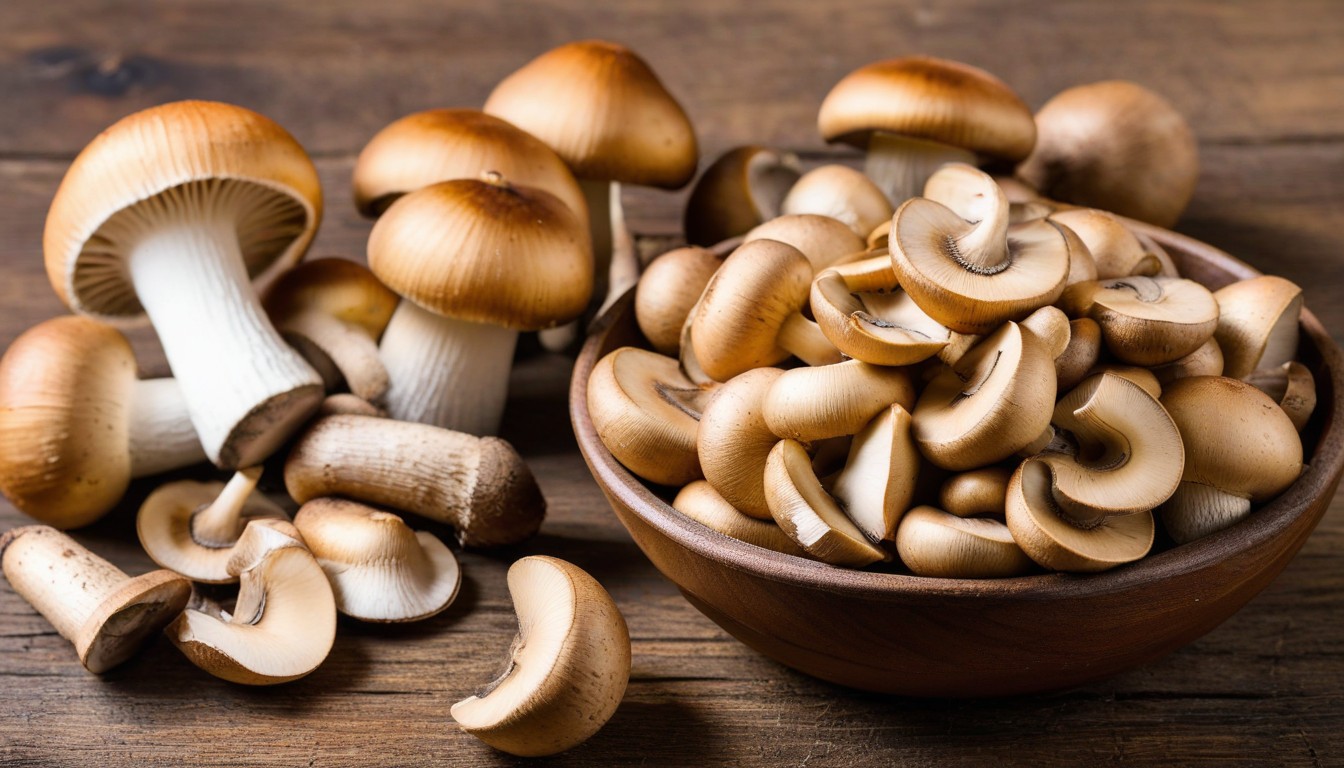
Mushrooms are a low-calorie food that can add a rich, savory flavor to any dish. But when it comes to nutritional value, is there a difference between canned and fresh mushrooms? Let’s take a closer look.
Vitamin Content
|
Vitamin |
Canned Mushrooms (per 100g) |
Fresh Mushrooms (per 100g) |
|---|---|---|
|
Vitamin B2 (Riboflavin) |
0.43 mg |
0.49 mg |
|
Vitamin B3 (Niacin) |
2.2 mg |
3.9 mg |
|
Vitamin B5 (Pantothenic Acid) |
0.42 mg |
1.3 mg |
|
Vitamin B6 (Pyridoxine) |
0.14 mg |
0.1 mg |
|
Vitamin D |
Not significant |
Not significant |
As shown in the table above, fresh mushrooms have a slightly higher vitamin content than canned mushrooms, specifically for niacin, pantothenic acid, and pyridoxine.
Mineral Content
|
Mineral |
Canned Mushrooms (per 100g) |
Fresh Mushrooms (per 100g) |
|---|---|---|
|
Potassium |
304 mg |
318 mg |
|
Phosphorus |
100 mg |
112 mg |
|
Selenium |
9.5 mcg |
9.2 mcg |
|
Zinc |
0.7 mg |
0.5 mg |
Fresh mushrooms contain slightly more potassium and phosphorus than canned mushrooms, while both options have similar levels of selenium and zinc.
Fiber and Protein Content
Fiber and protein are essential nutrients that support healthy digestion and muscle growth.
- Canned mushrooms contain approximately 1 gram of fiber and 1 gram of protein per 100g.
- Fresh mushrooms contain approximately 2-3 grams of fiber and 3-4 grams of protein per 100g.
Overall, while both canned and fresh mushrooms have similar nutritional profiles, fresh mushrooms tend to have slightly higher vitamin and mineral content, as well as fiber and protein. However, canned mushrooms can still be a convenient and cost-effective option for adding mushroom flavor to your dishes.
Storage and Shelf Life Factors
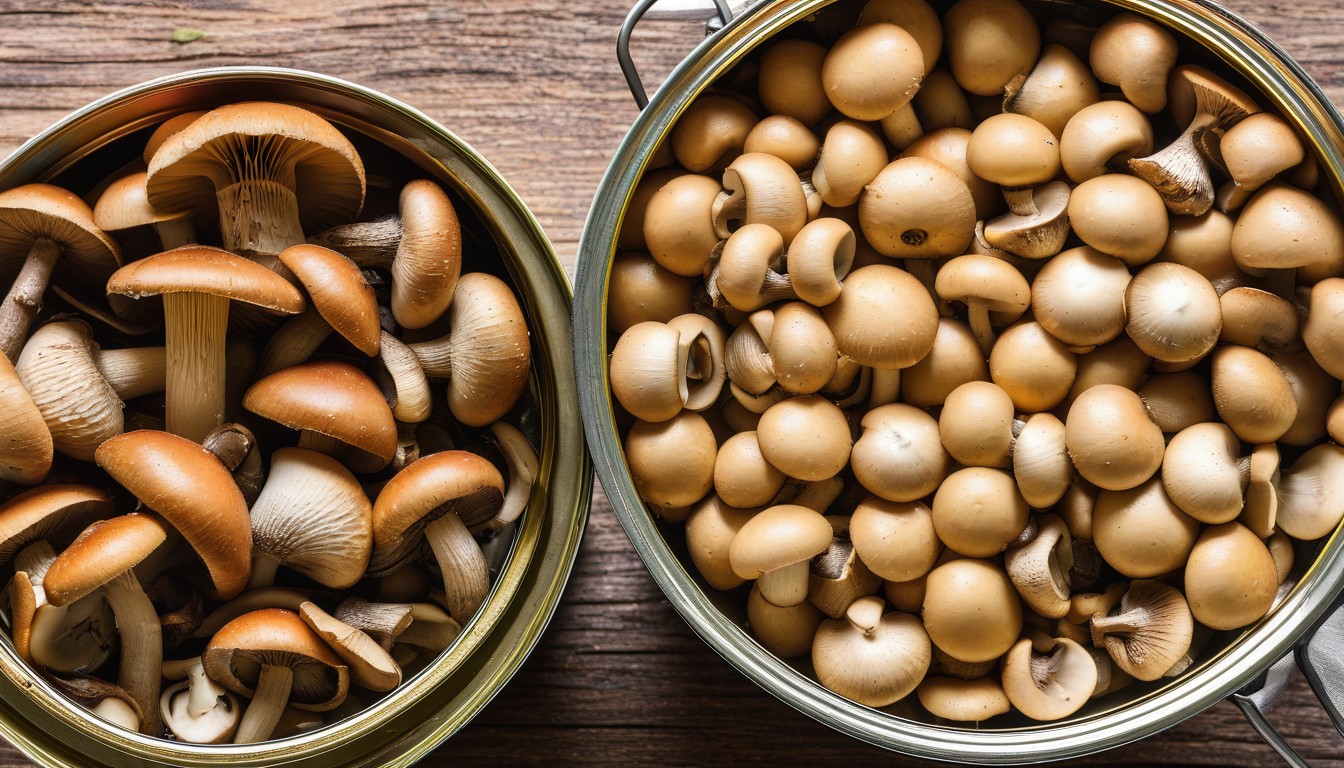
Proper storage is important to ensure that your mushrooms stay fresh and flavorful. Fresh mushrooms should be stored in a cool, dark place such as the refrigerator. To maximize their shelf life, you can wrap them in a damp paper towel and place them in a paper bag. Avoid sealing them in a plastic bag, as this can cause excess moisture and lead to spoilage.
Canned mushrooms, on the other hand, have a longer shelf life due to their preservation method. They can be stored in a cool, dry place such as your pantry for up to two years. Once opened, transfer them to a sealed container and keep them in the refrigerator for up to one week.
It’s important to note that while canned mushrooms have a longer shelf life, they may lose some of their texture and flavor over time. To ensure optimal taste and quality, it’s best to consume them within their recommended shelf life.
To summarize, proper storage is key to maintaining the freshness and flavor of both canned and fresh mushrooms. While canned mushrooms have a longer shelf life, fresh mushrooms can be stored in the refrigerator for several days and offer a more natural, earthy taste.
Culinary Uses: Canned vs Fresh Mushrooms
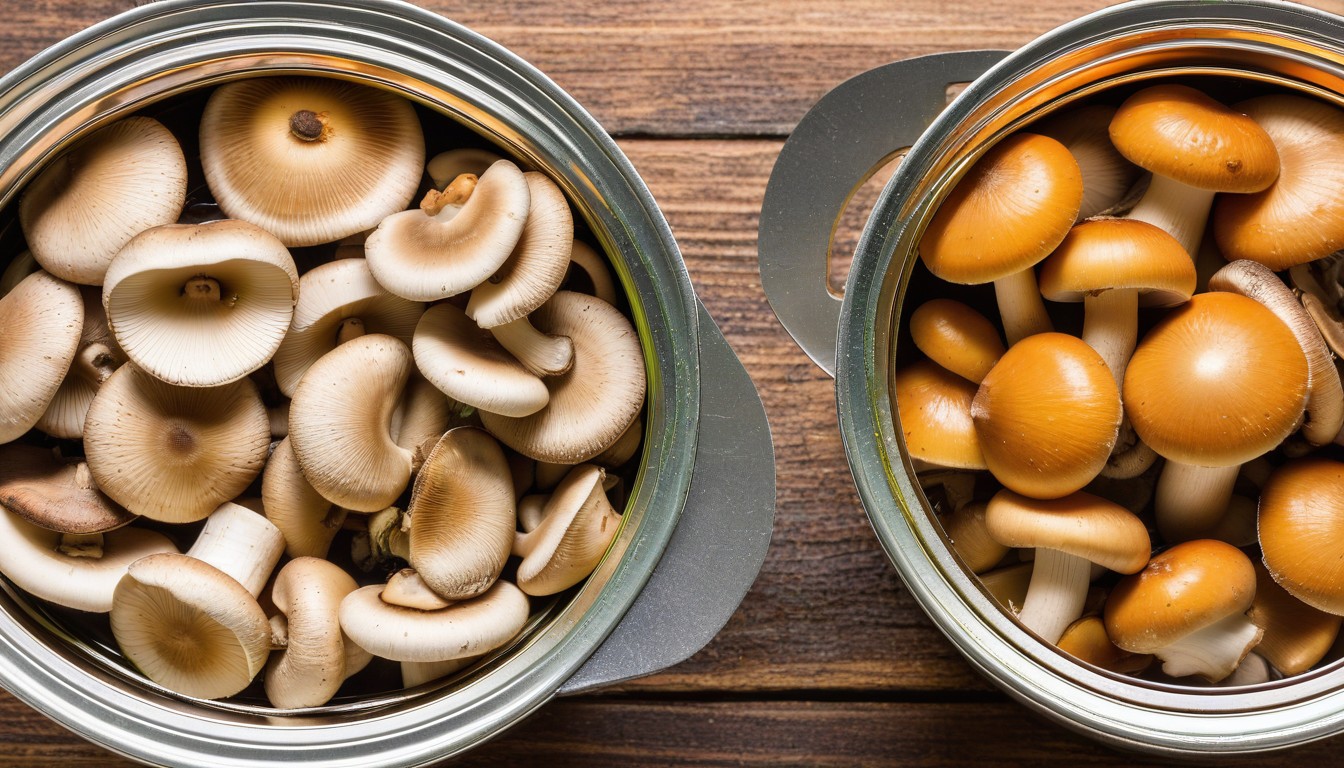
Mushrooms are a popular ingredient in various culinary applications. Whether you prefer canned or fresh mushrooms, both have applications in different dishes and cooking methods.
Canned Mushroom Uses
Canned mushrooms are perfect for recipes that require prolonged cooking times, such as stews, casseroles, and soups. They have a softer texture and a more umami-flavor that adds richness to dishes.
They also come pre-sliced, making them a convenient choice for salads, sandwiches or pizza toppings. Plus, they can be used straight out of the can, saving you time and effort in the kitchen.
Fresh Mushroom Uses
Fresh mushrooms have a meatier texture and a more robust flavor compared to canned mushrooms. They are perfect for recipes that require shorter cooking times such as stir-fries, sautés, or simple mushroom dishes like stuffed mushrooms or mushroom risotto.
They are also a popular choice for raw dishes, such as salads or as an appetizer served with dips or sauces. Fresh mushrooms can be sliced, chopped, or used whole, giving you endless culinary possibilities.
|
Canned Mushrooms |
Fresh Mushrooms | |
|---|---|---|
|
Texture |
Softer texture |
Meatier texture |
|
Flavor Profile |
Umami flavor |
Robust, earthy flavor |
|
Cooking Time |
Long cooking times |
Shorter cooking times |
|
Convenience |
Pre-sliced and ready to use |
Require washing and slicing |
When it comes to culinary uses, both canned and fresh mushrooms have their benefits. Canned mushrooms save time on preparation and work well in slow-cooked dishes, while fresh mushrooms offer a meatier, more robust flavor that shines in quick-cooking dishes or raw dishes.
Cost Comparison: Canned vs Fresh Mushrooms
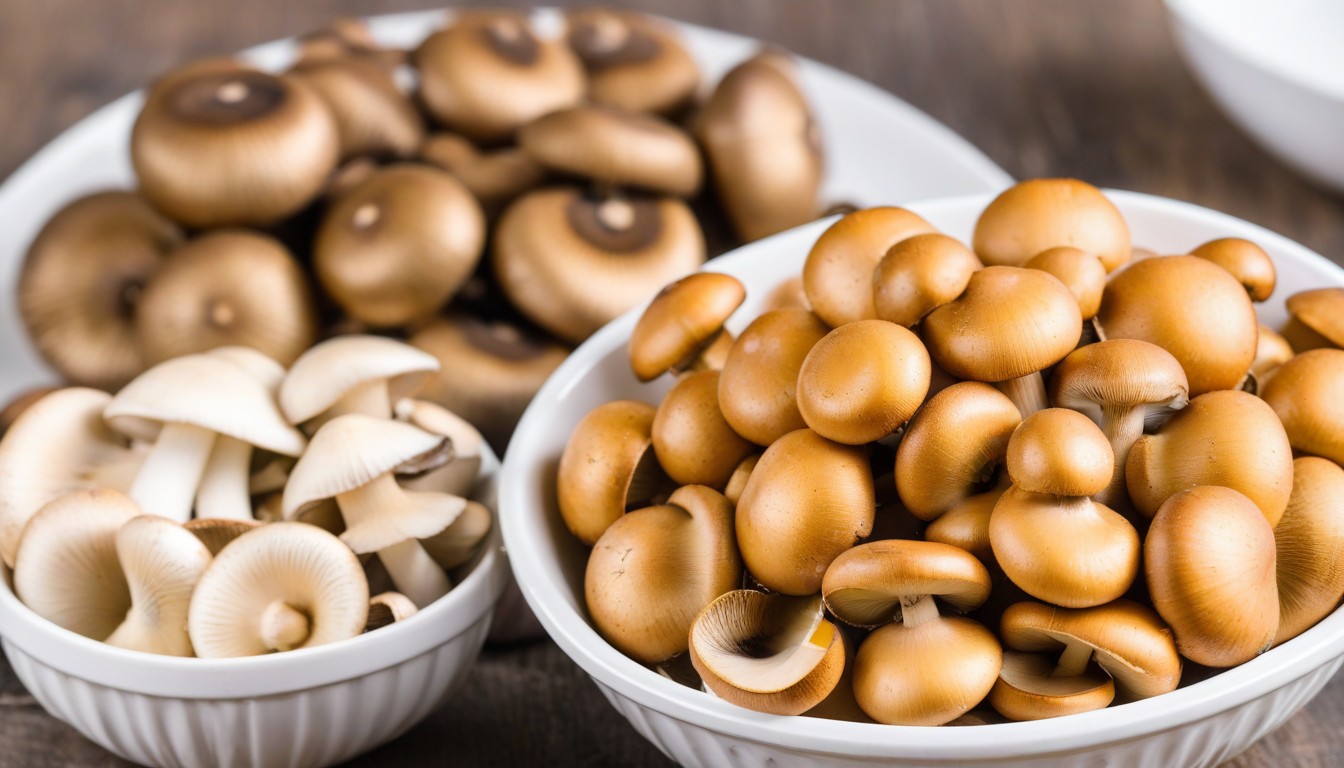
When it comes to cost, canned and fresh mushrooms differ significantly. Canned mushrooms are generally more affordable than fresh mushrooms, making them an excellent option for those on a budget. The price difference is due to the processing and packaging involved in canned mushroom production, which reduces the overall cost.
A can of mushrooms can cost anywhere from $0.50 to $1.50, depending on the brand and store. On the other hand, the price of fresh mushrooms is generally higher, ranging from $2 to $6 per pound, depending on the variety and season. While fresh mushrooms may seem more expensive, they offer superior quality and flavor, making them worth the investment for some.
If you’re trying to decide which option to choose, consider your budget, the amount of mushrooms you need, and your culinary goals. If you’re looking to bulk up your meals or prepare a large recipe, canned mushrooms may be the most cost-effective choice. However, if you’re looking for a superior flavor experience and are working with a smaller quantity, fresh mushrooms may be the way to go.
Environmental Impact: Canned vs Fresh Mushrooms
When it comes to making sustainable choices, the environmental impact of our food choices matters. Let’s take a closer look at the environmental considerations associated with canned and fresh mushrooms.
Packaging
Canned mushrooms often come in metal or aluminum cans, which can be recycled in most areas. However, the production and recycling of metals can have negative environmental impacts, such as energy consumption and greenhouse gas emissions. Fresh mushrooms typically come in plastic packaging, which can also be recycled in certain areas. However, plastic production and disposal have known environmental consequences, such as polluting water sources and harming wildlife.
Transportation
Canned mushrooms are often transported long distances to reach consumers, resulting in higher energy consumption and greenhouse gas emissions. In contrast, fresh mushrooms are often grown and consumed locally, reducing transportation-related environmental impacts.
Sustainability
Certain mushroom species, such as Shiitake, Oyster, and Maitake, are grown sustainably on logs or other natural materials, making them a more environmentally friendly option. However, many commercial mushrooms are grown in synthetic environments using non-renewable resources, contributing to environmental damage. Selecting sustainably grown mushrooms can reduce your environmental impact.
Conclusion
In conclusion, the choice between canned and fresh mushrooms depends on several factors. For those seeking a distinct flavor and texture, fresh mushrooms are the way to go. However, if convenience and extended shelf life are top priorities, canned mushrooms are a viable option.
Nutritionally, fresh mushrooms have higher levels of essential vitamins and minerals, making them the healthier choice. That said, both options offer health benefits and can be easily incorporated into a variety of recipes.
When it comes to cost, canned mushrooms are more budget-friendly than their fresh counterparts. Nonetheless, it’s worth considering the environmental impact of canned mushrooms as they are often packaged in metal cans, while fresh mushrooms are typically sold loose or in cardboard packaging.
To summarize, there’s no right or wrong choice when it comes to canned vs fresh mushrooms. It all boils down to your personal preferences and priorities. By understanding the nuances of each option and considering factors such as flavor, nutrition, storage, culinary uses, cost, and environmental impact, you can make an informed decision that’s tailored to your needs.
FAQ
Can I substitute canned mushrooms for fresh mushrooms in a recipe?
Yes, you can substitute canned mushrooms for fresh mushrooms in a recipe. However, it’s important to note that canned mushrooms have a different texture and flavor compared to fresh mushrooms, so the end result may vary slightly.
Are canned mushrooms as nutritious as fresh mushrooms?
Canned mushrooms have a slightly lower nutritional value compared to fresh mushrooms. The canning process can cause some loss of vitamins and minerals. However, canned mushrooms still provide a good source of fiber, protein, and antioxidants.
How long can canned mushrooms be stored?
Canned mushrooms have a long shelf life and can be stored for up to two years. It’s important to check the expiration date on the can and store them in a cool, dry place for optimal quality.
How long do fresh mushrooms last?
Fresh mushrooms typically last for about a week when stored properly in the refrigerator. It’s best to store them in a paper bag or a loosely closed container to maintain their freshness.
Are canned mushrooms suitable for raw consumption?
Canned mushrooms are usually cooked during the canning process, so they are safe to eat without further cooking. However, their texture and flavor may not be as desirable for raw consumption compared to fresh mushrooms.
Are fresh mushrooms more expensive than canned mushrooms?
Fresh mushrooms are generally more expensive than canned mushrooms. This price difference is due to the additional processing and packaging required for canned mushrooms, as well as the shorter shelf life of fresh mushrooms.
Are canned mushrooms more environmentally friendly than fresh mushrooms?
Canned mushrooms tend to have a lower environmental impact compared to fresh mushrooms. Canned mushrooms require less packaging and transportation, reducing carbon emissions and waste. However, choosing locally sourced fresh mushrooms can also be a sustainable option.
Can I use canned mushrooms in place of fresh mushrooms for sautéing?
Yes, you can use canned mushrooms for sautéing. However, keep in mind that canned mushrooms contain more moisture, so they may release liquid during cooking. Adjust your cooking time and technique accordingly to achieve the desired texture.

